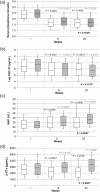A comparison of calcium acetate/magnesium carbonate and sevelamer-hydrochloride effects on fibroblast growth factor-23 and bone markers: post hoc evaluation from a controlled, randomized study
- PMID: 23787550
- PMCID: PMC3769980
- DOI: 10.1093/ndt/gft203
A comparison of calcium acetate/magnesium carbonate and sevelamer-hydrochloride effects on fibroblast growth factor-23 and bone markers: post hoc evaluation from a controlled, randomized study
Abstract
Background: Different phosphate binders exert differing effects on bone mineral metabolism and levels of regulating hormones. The objective of this post hoc evaluation of the CALcium acetate MAGnesium carbonate (CALMAG) study was to compare the effects of calcium acetate/magnesium carbonate (CaMg) and a calcium-free phosphate binder, sevelamer-hydrochloride (HCl), on serum levels of fibroblast growth factor-23 (FGF-23) and markers of bone turnover.
Methods: This secondary analysis of the controlled, randomized CALMAG study, comparing the effect of CaMg and sevelamer-HCl on serum phosphorus (P), aimed to investigate the parameters described above. The analysis included 204 patients who completed the initial study per protocol (CaMg, n = 105; sevelamer-HCl, n = 99).
Results: The study showed that serum levels of FGF-23 were significantly reduced with CaMg and sevelamer-HCl, with no difference between groups at Week 25 [analysis of covariance (ANCOVA); log-intact FGF-23 (iFGF-23), P = 0.1573]. FGF-23 levels strongly correlated with serum P levels at all time points in both groups. The bone turnover parameters alkaline phosphatase (AP), bone AP (BAP), procollagen type 1 amino-terminal propeptide 1 (P1NP), osteoprotegerin (OPG), beta-crosslaps (β-CTX) and tartrate-resistant acid phosphatase 5b (TRAP 5b) increased significantly in the sevelamer-HCl group; they remained almost unchanged in the CaMg group, after the initial phase of P lowering (ANCOVA, P < 0.0001 for all except OPG, P = 0.1718).
Conclusions: CaMg and sevelamer-HCl comparably lower serum levels of iFGF-23. Changes in bone parameters were dependent on characteristics of the phosphate binder; in contrast with sevelamer-HCl, CaMg had no influence on bone turnover markers.
Keywords: bone markers; calcium acetate; fibroblast growth factor-23; haemodialysis; magnesium carbonate; phosphate binder.
Figures

References
-
- Block GA, Hulbert-Shearon TE, Levin NW, et al. Association of serum phosphorus and calcium x phosphate product with mortality risk in chronic hemodialysis patients: a national study. Am J Kidney Dis. 1998;31:607–617. doi:10.1053/ajkd.1998.v31.pm9531176. - DOI - PubMed
-
- Covic A, Kothawala P, Bernal M, et al. Systematic review of the evidence underlying the association between mineral metabolism disturbances and risk of all-cause mortality, cardiovascular mortality and cardiovascular events in chronic kidney disease. Nephrol Dial Transplant. 2009;24:1506–1523. doi:10.1093/ndt/gfn613. - DOI - PubMed
-
- Lezaic V, Tirmenstajn-Jankovic B, Bukvic D, et al. Efficacy of hyperphosphatemia control in the progression of chronic renal failure and the prevalence of cardiovascular calcification. Clin Nephrol. 2009;71:21–29. - PubMed
-
- Plantinga LC, Fink NE, Melamed ML, et al. Serum phosphate levels and risk of infection in incident dialysis patients. Clin J Am Soc Nephrol. 2008;3:1398–1406. doi:10.2215/CJN.00420108. - DOI - PMC - PubMed
-
- Tentori F, Blayney MJ, Albert JM, et al. Mortality risk for dialysis patients with different levels of serum calcium, phosphorus, and PTH: the Dialysis Outcomes and Practice Patterns Study (DOPPS) Am J Kidney Dis. 2008;52:519–530. doi:10.1053/j.ajkd.2008.03.020. - DOI - PubMed
Publication types
MeSH terms
Substances
LinkOut - more resources
Full Text Sources
Other Literature Sources
Medical

